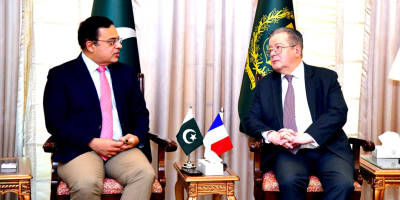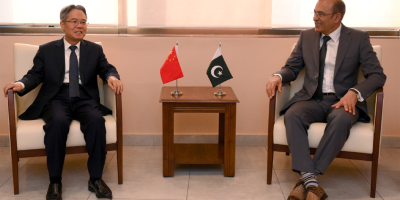Karachi’s Green Line bus will be more beautiful than Lahore metro: PM

KARACHI: “It will be more beautiful than the Lahore metro bus,” Prime Minister Nawaz Sharif told his audience during the groundbreaking ceremony of Karachi’s Green Line Bus Rapid Transit (BRT) system held at Nazimabad area’s Anu Bhai Park on Friday.
Upon his arrival in Karachi earlier, Premier Nawaz was received by CM Qaim, Sindh Governor Ishratul Ibad Khan and Director General Rangers Major General Bilal Akbar at the Pakistan Air Force (PAF) Faisal air base.
“The elevated section is 11.7 kilometres long and 7.7km is the length of the section on the ground,” he said. “There will be 22 bus stations and separate lanes for coming and going.”
The Green Line was to meet the Blue Line at Gurumandir and then go on to Tower, he said, adding that because work was delayed on the Blue Line, he asked for the Green Line to be extended to the central business district.
The BRT will make life easy for residents of the areas it passes through, he said.
Lauding the transparency, efficiency and cost-savings on the project, the premier was hopeful it would be completed by next year, but “can’t promise it will be complete by April or May”.
Work will start on the Lyari Expressway in March, for which the federal government has released Rs1.9 billion already, he said.
He said work on the Karachi-Hyderabad motorway has started, while construction of the Hyderabad-Sukkur section of the motorway will be set to start within a month. The Sukkur-Multan and Multan-Lahore sections will also start soon, he said.
“These are mega projects that not only close distances, but also brings people’s hearts closer,” the prime minister said.
The prime minister also attended a high-level meeting which discussed the law and order situation of the city.
“In Karachi, kidnapping, ransom, extortion, murder and crime have decreased to a great extent. During the, I said now that crime in Karachi is declining, we have to proceed with resolve so the city remains free of crime,” he said.
“We will not halt the operation until the city of lights begins to shine again,” he said. “Karachi could have been the best city in South Asia, but we went off track and things kept getting worse. Now we are trying to fix things and need everyone to cooperate.”
Sindh Chief Minister Qaim Ali Shah thanked the PM for cooperating with the Sindh government on the mass transit project.
He said the Green Line will stretch from Surjani to Saddar. “It will be 18 kilometres long,” he said.
“There are five other lines to complete,” he said, adding, “We will try to complete them in two, two and a half years.”
“However, Karachi is also in need of power and water. In that matter, the prime minister said the federal government will partner with Sindh fifty-fifty. These projects have been started… and we hope the bulk of them will be completed within two and a half years.”
Qaim took notice of the improved security situation in Karachi and praised the Rangers and police for ensuring the city and province remain peaceful.
Governor Sindh Dr Ishratul Ibad said work on the Lyari Expressway will be started within ten days, and construction of the various BRT lines has been started.
He requested the PM to help the Sindh government with the planned Malir Expressway ─ “a new artery” for Karachi and the Circular Railway and asked him to order that the projects be expedited.
The Green Line starts at Surjani Town and is to end at Municipal Park, M.A. Jinnah Road and will benefit nearly 300,000 passengers per day. The project is expected to be completed within one year.
The prime minister first announced the project at a high level meeting in July 2014. The project is to be completed with an estimated cost of Rs16.85 billion, which will be funded by the federal government, an official said earlier.
The project aims to construct a bus-way, dedicated for BRT vehicles, in the median of roads along the entire length of proposed route.
The bus stations will be built in the median, with ground-level and elevated sections with the purpose of providing high speed and high capacity service.
Seven corridors had been identified under the Karachi Master Plan for introducing the mass transit system.
The design capacity of the proposed BRT system with passing lanes provision will increase based on the number of direct and express services run between stations in the future, as required.
Special Assistant to the CM Omer Rehman Malik had said that the project, which would be a 26km-long route with 24 stations, had been designed to provide transport to 150,000 commuters daily and it would be completed by 2017.
According to a report released last year, compiled by renowned city planner and architect Arif Hasan with Mansoor Raza stated that Karachi, a city of an estimated 22 million people, had roughly 9,527 operational minibuses, as compared to the 22,313 it had in 2011. The Karachi Metropolitan Corporation (KMC) had said that an additional 8,676 large buses are required to fill the shortfall.
Out of the city’s 329 official bus routes, only 111 are currently being operated, while the others have been abandoned because “they are not considered lucrative by the transporters”.
Starting with the Karachi Improvement Trust (KIT) in 1950, a detailed history of nine successive government-sponsored bus initiatives in the public transport sector showed that all the planned projects eventually collapsed due to mismanagement, inefficiency or a lack of follow-through on promises made to private partners.
While several of the initiatives were initially successful, most collapsed under financial strain, the report says. These failures include, but are not limited to: the KIT (1950-57); Karachi Transport Syndicate (1957-58); Karachi Road Transport Corporation (1959-67); Sindh Road Transport Corporation (1967-77); and the Karachi Transport Corporation (1977-96).
Related News

French Ambassador Reaffirms Full Support for AFD-Funded Development Projects in Meeting with Federal Minister Ahad Cheema
ISLAMABAD: MAY 29 (DNA):The Ambassador of France to Pakistan, Nicolas Galey, called on Federal MinisterRead More

Chinese Ambassador visits NUST; Calls for deeper Sino-Pak academic ties
ISLAMABAD , MAY 29 (DNA):Marking a momentous step forward in deepening bilateral academic cooperation, HERead More


Comments are Closed